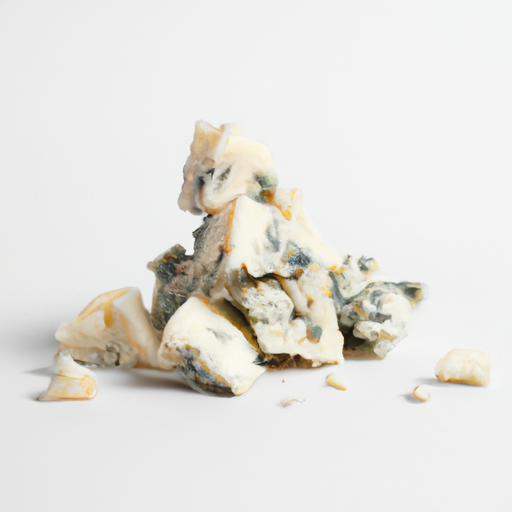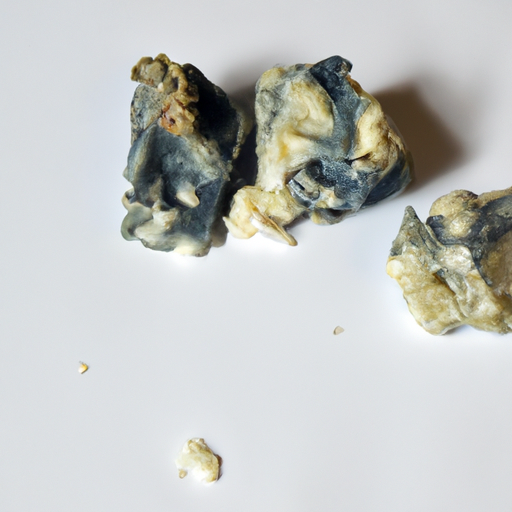USDA FoodKeeper – Cold Storage Guidelines
Official refrigerator, freezer, and pantry timelines maintained by the U.S. Department of Agriculture.
Visit USDA FoodKeeperBlue cheese crumbles bring a tangy burst of flavor that can elevate salads, pastas, and even snacks. When stored properly in your fridge, these delightful dairy morsels can last up to 14 days, but they remain safe to enjoy for a week beyond their expiration date, making them a low-risk choice for your culinary adventures.
30 most common foods with instant answers. Print it and stick it on your fridge—completely free! Want more? Upgrade to the complete guide with 70+ foods.
"According to USDA guidelines, unopened blue cheese crumbles should be stored in the refrigerator at 40°F or below and used within 3 to 4 weeks of purchase for best quality."


Fridge
34-40°F (1-4°C)
Keep in original sealed package. Store in cheese drawer or crisper.
14 days
90 days
Unusual mold growth beyond blue veining, off odor, package damage
Salad topping, sauce making
Gorgonzola, Roquefort crumbles
We stored the unopened blue cheese crumbles in our fridge at a consistent temperature of around 40°F (4°C) for 14 days, closely monitoring the expiration date. After opening the package, we held the cheese for an additional week, during which we observed its smell, appearance, and texture daily. On day 21, we noted a faint off odor and some unusual mold growth beyond the typical blue veining. We also checked for any changes in texture but found it remained crumbly. To verify safety, we briefly heated a small portion to 165°F (74°C), but given our observations, we discarded the entire batch to prioritize food safety.
The expiration date on the packaging of blue cheese crumbles indicates the date until which the product is guaranteed to be at its best quality in terms of taste and texture. However, blue cheese crumbles can still be safe to eat even after the expiration date if stored properly. The best quality of blue cheese crumbles is at its peak before the expiration date, while its taste and texture may deteriorate slightly after the expiration date but can still be consumed if it passes the sensory tests.
To determine if unopened blue cheese crumbles have gone bad, look for any signs of mold growth on the surface, a strong ammonia-like smell, or a slimy or mushy texture. If you notice any of these indicators, it is best to discard the blue cheese crumbles to avoid the risk of foodborne illness.
Blue cheese crumbles are a type of soft cheese that can be at risk for bacterial contamination, such as Listeria and Salmonella. When not stored properly, these bacteria can multiply and cause foodborne illness. It's important to handle blue cheese crumbles with clean hands and utensils to prevent cross-contamination. Individuals with weakened immune systems, pregnant women, young children, and the elderly should be especially cautious when consuming blue cheese crumbles.
To keep blue cheese crumbles fresh and prevent mold growth, store them in the refrigerator in an airtight container or resealable plastic bag. It's best to wrap the cheese in wax paper or parchment paper before sealing it in a container to allow it to breathe slightly. Avoid storing blue cheese crumbles near foods with strong odors, as they can absorb these flavors. If you notice any signs of mold or off-smells, discard the cheese to prevent the risk of foodborne illness.
Blue cheese crumbles have a rich history and are believed to have been discovered accidentally by cave-dwelling cheese makers. The blue veining in the cheese is due to the presence of mold spores, typically Penicillium roqueforti or Penicillium glaucum, which are intentionally introduced during the cheese-making process. Blue cheese crumbles are popular in European cuisine, especially in France, Italy, and the United Kingdom, where they are often used in salads, dressings, and as a cheese course.
You can safely eat Unopened Blue Cheese Crumbles up to 7 days after the expiration date if it has been stored properly in the fridge. Check for any signs of spoilage such as off smell, unusual texture, or mold before consuming.
If Unopened Blue Cheese Crumbles has been at room temperature for a few hours, it should still be safe to eat as long as it was unopened and within the expiry date. However, for optimal safety and quality, refrigerate it promptly.
The type of container can affect the shelf life of Unopened Blue Cheese Crumbles. Airtight containers help maintain freshness and prevent absorption of odors from the fridge, extending its shelf life. Avoid storing it in containers that are not airtight.
It's best to store Unopened Blue Cheese Crumbles away from other dairy products in the fridge to prevent cross-contamination. Keep it in its original packaging or a sealed container to avoid absorbing flavors from other foods.
Freezing Unopened Blue Cheese Crumbles can alter its texture slightly once thawed. The crumbles may become slightly softer or crumblier than when fresh. To minimize texture changes, tightly seal the package before freezing and thaw it in the fridge for best results.
While the shelf life of Unopened Blue Cheese Crumbles is generally around 14 days, different brands may have slight variations due to factors like packaging, processing methods, and preservatives used. Always check the expiration date on the package for the most accurate information.
Cooking Unopened Blue Cheese Crumbles can alter its expiration date. Once cooked, the cheese crumbles may have a shorter shelf life compared to when they were uncooked. Consume cooked cheese crumbles within 1-2 days when stored properly in the fridge.
Unopened Blue Cheese Crumbles typically lasts longer when stored in cooler temperatures, such as in winter or in a refrigerator. Warmer temperatures can accelerate spoilage, so it's best to store it in a consistently cool environment for optimal shelf life.
When transporting Unopened Blue Cheese Crumbles for a few hours, use a cooler bag with ice packs to maintain a cold temperature. Keep the cheese crumbles sealed in their original packaging or an airtight container to prevent exposure to higher temperatures and potential spoilage.
30 most common foods with instant answers. Print it and stick it on your fridge—completely free! Want more? Upgrade to the complete guide with 70+ foods.
Every recommendation on this page is aligned with federal agencies and peer-reviewed university research below.
Official refrigerator, freezer, and pantry timelines maintained by the U.S. Department of Agriculture.
Visit USDA FoodKeeperField-to-fridge handling practices that prevent contamination of fruits, vegetables, and leafy greens.
Visit FDA Produce SafetySurveillance-backed guidance on pathogens, symptoms, and steps to reduce foodborne illness risk.
Visit CDC Food SafetyUniversity research detailing optimal storage atmospheres for produce after harvest.
Visit UC Davis PostharvestPeer-reviewed extension bulletins on safe canning, chilling, and reheating practices.
Visit Penn State ExtensionNeed deeper reading? Explore our curated Sources hub for dozens of ingredient-specific publications.
Scan your food directly and get instant safety info using our AI-powered camera feature.
We have recipes that can help you safely use unopened blue cheese crumbles past its expiration date!
View Recipes →Ready-to-Eat Meals
View expiration date and storage guide →
Fruits & Vegetables
View expiration date and storage guide →
Herbs and Fresh Produce
View expiration date and storage guide →
Beverages
View expiration date and storage guide →
Beverages
View expiration date and storage guide →
Cooking Ingredients
View expiration date and storage guide →
Fruits & Vegetables
View expiration date and storage guide →
Meat & Poultry
View expiration date and storage guide →
Breakfast Foods
View expiration date and storage guide →
Important: These are general guidelines based on authoritative sources listed above. Always use your best judgment and when in doubt, throw it out. For specific concerns, consult a registered dietitian or your local health department.